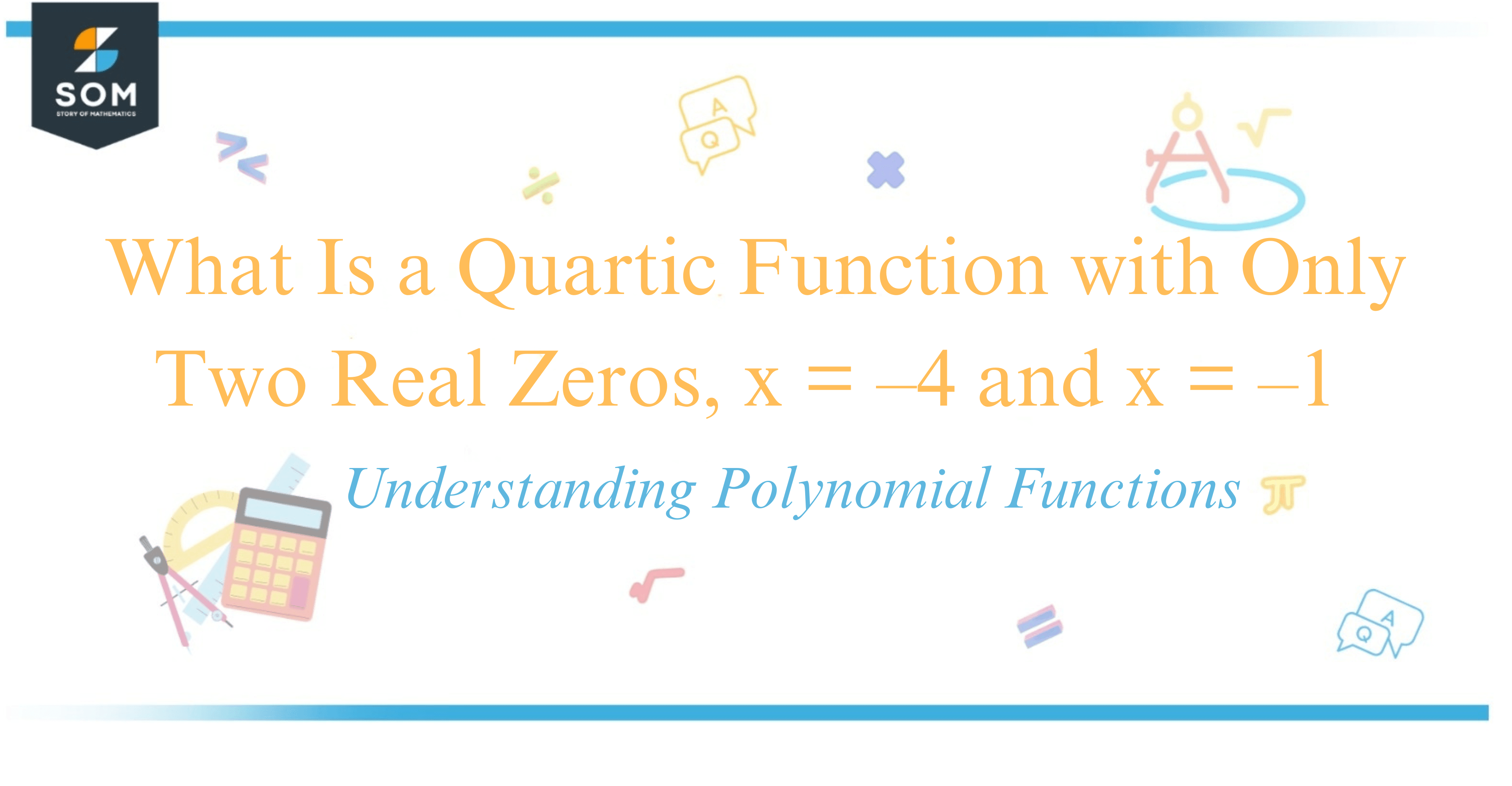
A quartic function is a type of polynomial with a degree of four, which means its highest exponent is four. It can be expressed in the form $y = ax^4 + bx^3 + cx^2 + dx + e$ where $a$, $b$, $c$, $d$, and $e$ are constants, and $a \neq 0$.
When considering the real zeros of a quartic function, specifically $x = –4$ and $x = –1$, these values represent the $x$-coordinates where the function intersects the $x$-axis.
In a quartic function with these given zeros, I can determine a formula that will include these points by using them as roots in the polynomial.
For instance, if a function has roots at $x = –4$ and $x = –1$, then $(x + 4)$ and $(x + 1)$ must be factors of this function. To ensure that these are the only real zeros, the remaining factors must not yield any real zeros.
Thus, the other two factors could be complex or repeated factors of the given real zeros to maintain a degree of four.
Stick around, and I’ll show you how a quartic function behaves on a graph with these specific zeros and how these zeros are critical in determining the shape and the intersection points of the quartic function‘s curve.
Quartic Function With Only Two Real Zeros
In my exploration of quartic functions, which are fourth-degree polynomials, I’ve come across an interesting scenario.
A quartic function typically has the form $f(x) = ax^4 + bx^3 + cx^2 + dx + e$ where $a$, $b$, $c$, $d$, and $e$ are real coefficients, and the variable $x$ represents the input to the function.
The quartic function can have up to four real roots (or real zeroes), but what about when it only has two?

Imagine I have a quartic equation that is known to have exactly two real zeroes: $x = -4$ and $x = -1$. To construct a quartic function with these zeroes, I know that $(x + 4)$ and $(x + 1)$ must be factors of the function. However, since I want exactly two real roots, these factors need to be squared to prevent the existence of additional real zeroes. Therefore, the equation of the function could be written as:
$$f(x) = (x + 4)^2(x + 1)^2$$
Expanding this out gives me the actual quartic function:
$$f(x) = x^4 + 10x^3 + 35x^2 + 50x + 16$$
The leading term is $x^4$, which confirms that the function is indeed a quartic. The graph of this function will touch the x-axis at $x = -4$ and $x = -1$, corresponding to the real zeroes, and will not cross it since these roots have even multiplicity.
As for the range of the function, it will be $[16, \infty)$ since the leading term has a positive coefficient, and the function has a minimum point where it achieves the value of 16. There will be a local maximum between the two real roots, which could also be the inflection point.
The degree 4 nature of the function means the graph will exhibit a maximum of three turning points. Given the real coefficients, the graph will extend indefinitely in both the positive and negative directions along the y-axis.
| Key Features | Description |
|---|---|
| Degree | 4 (quartic) |
| Real Roots | $x = -4$, $x = -1$ (each repeated) |
| Inflection Point | Possibly between $x = -4$ and $x = -1$ |
| Range | $[16, \infty)$ |
Example of a Quartic Function
In exploring the world of polynomials, I often come across an interesting type called a quartic function. This is a type of polynomial where the highest power of the variable, usually “x,” is four, which means it has a degree of four.
Now, let’s say I have a quartic function that has specifically two given real zeros: x=–4 and x=–1. What does this imply for the function itself?
Well, for a quartic equation to have real zeros at x=–4 and x=–1, these zeros must each appear as a factor twice since a quartic will have four total zeros (real or complex).
This gives us two quadratic factors: $(x+4)(x+4)$ and $(x+1)(x+1)$. To construct the entire quartic polynomial, I would multiply these factors together. That said, the resulting equation then becomes:
$$ (x+4)^2 \cdot (x+1)^2 = x^4 + 10x^3 + 35x^2 + 50x + 16 $$
This equation represents our quartic function. Importantly, should I desire to solve this equation for all zeros, I will notice that it naturally factors into the quadratic factors I began with, confirming that the only real zeros of the function are at x=–4 and x=–1.
Understanding this example can help envision how quartic polynomials behave. They can curve up and down, possibly several times, since they can have up to four turning points.
If we graph our resulting function, we will note the presence of the two real zeros as intersecting x-axis points.
Conclusion
In this exploration of quartic functions, I’ve discussed the properties of a quartic function with specified real zeros at ( x = -4 ) and ( x = -1 ).
To construct such a function, we consider that each zero has to be accounted for twice because a quartic function is a polynomial of degree four, and thus, needs to have four zeros—real or complex.
Given the real zeros, I propose a quartic function in the form $f(x) = (x + 4)^2(x + 1)^2 $. When this is expanded, we would obtain a quartic function that satisfies the given conditions.
After expansion, the equation transforms into $f(x) = x^4 + 10x^3 + 35x^2 + 50x + 20$, which is a valid representation of the requirements.
Furthermore, it’s critical to mention that if a quartic function is expected to have only two real zeros, the remaining two zeros must be complex and occur in a conjugate pair.
This is a result of the Fundamental Theorem of Algebra and ensures the equation remains with real coefficients.
I hope my clarification helps understand how to construct a quartic function based on given real zeros. Remember, the complex zeros are not explicitly shown in this case but can be inferred based on the fundamental properties of polynomials.
